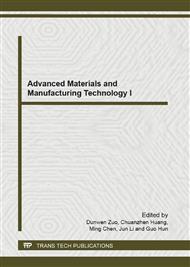p.287
p.293
p.297
p.303
p.309
p.313
p.317
p.321
p.325
Study on Surface Roughness of Ultrasonic Vibration Assisted Milling
Abstract:
The object of this paper is to experimentally investigate the effects of ultrasonic vibration on the roughness of surface produced by the side cutting edge of an end milling cutter. Two respective surface roughness models for conventional milling (CM) and ultrasonic vibration assisted milling (UVAM) were proposed using experimental data. RSM and ANOVA were used for analysis. As a result, it is found that the surface roughness of vertical side surface of slot improves obviously after applying ultrasonic vibration. The result of ANOVA indicated that the target surface roughness depends on the combined action of several key machining parameters in UVAM, and therefore their choosing and optimizing is very important to achieving small surface roughness.
Info:
Periodical:
Pages:
309-312
Citation:
Online since:
January 2012
Authors:
Keywords:
Price:
Сopyright:
© 2012 Trans Tech Publications Ltd. All Rights Reserved
Share:
Citation:


